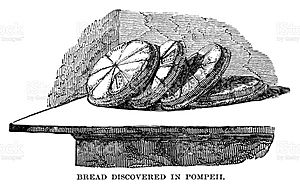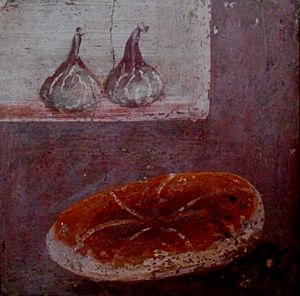Herculaneum loaf facts for kids
The Herculaneum loaf is a special piece of bread. It was baked a long time ago, on August 24, 79 AD, in a Roman town called Herculaneum. This bread is amazing because it was partly saved from a huge volcanic eruption! It turned into a charcoal-like form, which helped it last.
Archaeologists found this loaf in 1930. It was discovered in a large house that belonged to a man named Quintus Granius Verus. A stamp on the bread even helped prove he owned the house!
Today, you can see the Herculaneum loaf at the National Archaeological Museum, Naples in Italy.
How the Herculaneum Loaf Was Preserved

The Herculaneum loaf was baked on August 24, 79 AD. On that day, the Mount Vesuvius volcano erupted. This eruption covered the town of Herculaneum.
The bread was inside a brick oven. This oven helped protect it from the super-hot ash and gas. This hot ash and gas is called a pyroclastic flow. It was so hot that it turned the bread into a charcoal-like substance. This process is called carbonisation. It helped the bread last for nearly 2,000 years!
Other similar loaves have been found too. Many were discovered in nearby Pompeii and Herculaneum. For example, 81 loaves were found in one oven.
These ancient foods often look smaller than they were. This is because they lost all their water. The breads likely shrunk a lot. They were exposed to temperatures of at least 400°C (752°F). Even with this heat, the marks and stamp on the Herculaneum loaf are still very clear.
Discovery of the Ancient Bread
The Herculaneum loaf was found in 1930. It was during an archaeological dig. This dig happened between 1929 and 1932.
The bread was found in a large house. This house is known as the House of the Stags. It was a very important discovery.
Today, the loaf is kept safely. You can see it at the National Archaeological Museum, Naples.
What Makes the Herculaneum Loaf Special

Scientists have studied the dough of this bread. They found out it was a sourdough bread. This means it was made using a special starter. This starter contains natural yeast.
Experts have even been able to guess the recipe. They did this by carefully studying the ancient bread.
Before baking, the loaf was cut. These cuts divided the bread into wedges. This made it much easier to share. You can see similar cut loaves in old Roman art.
The bread also had a string tied around it. This string helped make each loaf the same size. It also made the bread easier to carry. You can still see the clear line where the string was. It goes all around the side of the loaf.
The loaf has a stamp on it. The stamp says, "Of Celer, slave of [Quintus] Granius Verus." In Roman times, bread was often marked. This was common if it was taken to a shared bakery.
Celer was the original owner of this bread. He was a slave. It is believed that Celer survived the volcano eruption. His name appears later on a list of freed slaves.
Celer's master was Quintus Granius Verus. He was an important city elder. The bread is important because it helped prove he owned the House of the Stags. This is where the loaf was found. Quintus Granius Verus came from a successful merchant family.

